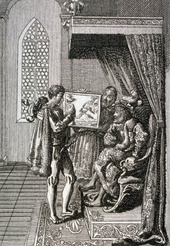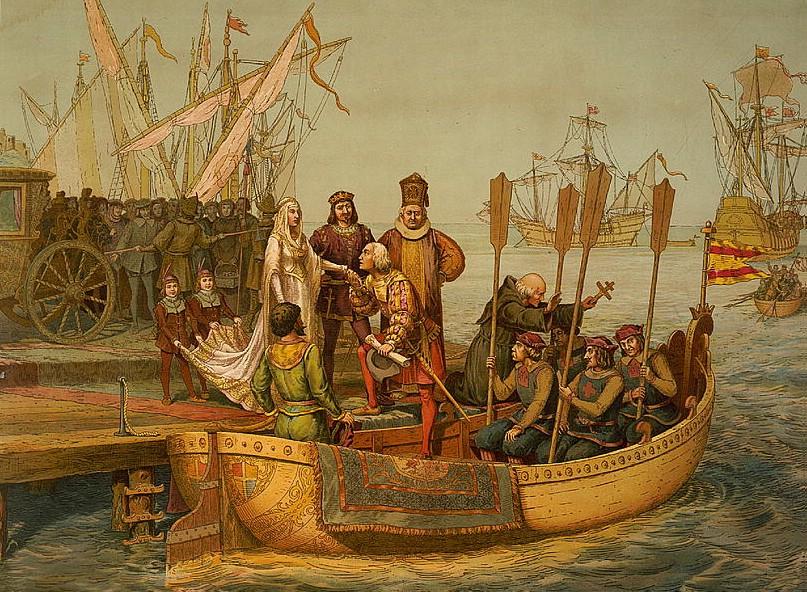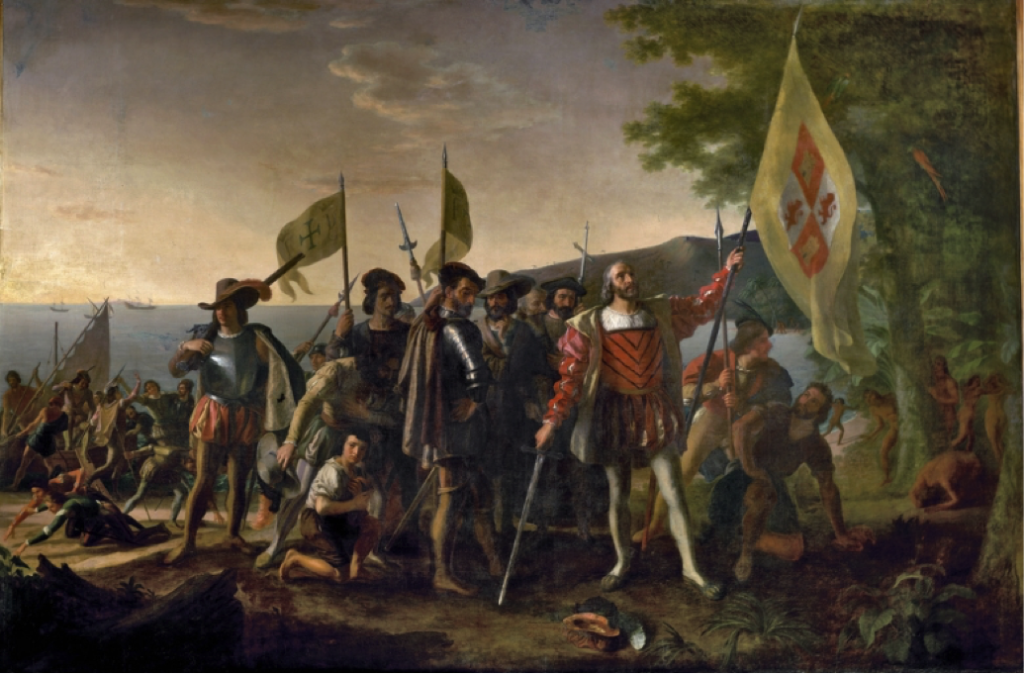
Understanding the Legacies of Christopher Columbus
Christopher Columbus
A newspaper cartoon showed a sign in the front window of Jack’s Department Store: “Columbus Day Sale. All merchandise marked up 200 percent. Because, let’s face it, Columbus was a greedy opportunist, just like Jack.”
To a generation of school children, Columbus was a man of mythic stature, an explorer, and a discoverer who initiated the modern age and carried European civilization across the Atlantic Ocean.

Lately, Columbus has been depicted as an imperialist, a racist, and a genocidal despoiler of the natural environment. Indian peoples called Columbus the father of colonial greed, slavery, and genocide. In 1992, the National Council of Churches voted to condemn Columbus’s arrival as a genocide.
At 2 a.m., October 12, 1492, a sailor on board the Spanish ship the Pinta sighted a distant cliff in the moonlight. For 88 weary men who had been sailing for nine weeks in search of Asia, the sight was a godsend. Members of the crew had been talking of mutiny for several days, but now they asked for forgiveness. At dawn, Columbus put ashore in full regalia and claimed the land in the name of the King and Queen of Spain.
When Columbus and his men came ashore, the native Indians, known as the Arawak, greeted them with food, water, and gifts. This is the way Columbus described the encounter:
They brought us parrots and balls of cotton and many other things, which they exchanged for glass beads. They willingly traded everything they owned. They do not bear arms and do not know them, for I showed them a sword, they took it by the edge and cut themselves out of ignorance. With 50 men we could subjugate them all and make them do whatever we want.
On the basis of Columbus’s report, a second expedition was given seventeen ships and more than 1,200 sailors. Their aim was clear: gold and slaves. In Haiti, Columbus and his men rounded up 1,500 Arawak and put them in pens guarded by dogs. Five hundred were loaded on ships and taken to Spain. Some 200 died en route. Columbus also ordered all Indians fourteen years of age and older to collect a certain quantity of gold every three months. When they handed over that amount, the Indians were given copper tokens to hang around their necks. Indians without a copper token had their hands cut off and bled to death.

History Through…
… Portraits: What did Christopher Columbus Look Like?
Christopher Columbus arguably had a greater impact on the course of world history than anyone else in the past thousand years. Yet we know remarkably little about him. Encyclopedias and textbooks generally state that he was born in 1451 in Genoa, but serious scholars still dispute when and where he was born, his ethnicity, how he was educated, where he landed in 1492, and even where he is buried.
The 1893 commemoration of Columbus’s voyages of discovery, the World’s Columbian Exposition in Chicago, displayed 71 portraits reputedly of Columbus. None were painted from life.
But we do have three surviving written descriptions.
The earliest published description of Columbus appeared in 1504, and described him as “Genoese, a man of tall and imposing stature, ruddy, of great intelligence, and with a long face.” This description is attributed to Angelo Trivigiano, who was secretary to the Venetian ambassador at the court of Ferdinand and Isabella.
Three decades later, Conzalo Fernandez de Oviedo described him as a man “of good stature and appearance, taller than middling and with strong limbs, the eyes lively and other parts of the countenance of good proportion, the hair very red, and the face somewhat flushed and freckled.”
Fernando Colon described his father as follows;
The Admiral was a well-built man of more than average stature, the face long, the cheeks somewhat high, his body neither fat nor lean. He had an aquiline nose and light-colored eyes; his complexion was light and tending to bright red. In youth his hair was fair, but when he reached the age of thirty, it all turned white. In eating and drinking, and in the adornment of his person, he was very moderate and modest. He was affable in conversation with strangers and very pleasant to the members of his household, though with a certain gravity. He was so strict in matters of religion that for fasting and saying prayers he might have been taken for a member of a religious order. He was so great an enemy of swearing and blasphemy that I give my word I never heard him utter any other oath than ‘by St. Ferdinand!’ and when he grew very angry with someone his rebuke was to say ‘God take you’ for doing or saying that. If he had to write anything, he always began by writing these words: IESUS cum MARIA sit nobis in via [“may Jesus with Mary be with us on the way”]. And so fine was his hand that he might have earned his bread by that skill alone.
Lorenzo Lotto, 1512







History in the Headlines
1492 is the most significant year in modern world history. Not only did it bring the Old and New Worlds together, it also initiated a set of changes that would have vast implications for the future.
It contributed to the rise of the transatlantic slave trade and a vast movement of people, animals, food, plants, and diseases that would transform the world.
Alfred Crosby, a Professor Emeritus, University of Texas at Austin, stated:
Millions of years ago, continental drift carried the Old World and New Worlds apart, splitting North and South America from Eurasia and Africa. That separation lasted so long that it fostered divergent evolution; for instance, the development of rattlesnakes on one side of the Atlantic and vipers on the other. After 1492, human voyagers in part reversed this tendency. Their artificial re-establishment of connections through the commingling of Old and New World plants, animals, and bacteria, commonly known as the Columbian Exchange, is one of the more spectacular and significant ecological events of the past millennium.
History Now, Issue 12, June 2007
Hidden History
Columbus & Myth-Making
A host of myths surround Christopher Columbus and his epic voyage.

One such myth is that Queen Isabella sold her crown jewels to pay for his voyage. Not true. The city of Palos owed the Queen a debt, which it repaid by providing two of Columbus’s ships.
Another such myth is that he was the first person to recognize that the Earth was round. In fact, all educated people knew that the world was spherical, though there was disagreement about its diameter. In the end, Columbus grossly underestimated the earth’s circumference.
Then there is the myth that Columbus was the first European to set foot in what is now the United States. In fact, Columbus never set foot on North America.
So how then did this myth arise?
It was popularized in an 1828 multi-volume biography by Washington Irving; best remembered today as the author of Rip Van Winkle and The Legend of Sleepy Hollow. Entitled, A History of the Life and Voyages of Christopher Columbus, the book asserted that Columbus alone advocated that the earth was round in the face of a religious establishment that insisted that the world was flat.
Washington Irving was influential in creating many popular myths and legends. In addition to the Headless Horseman, he was among the first to popularize St. Nicholas (who later generations would call “Santa Claus”) as a pipe-smoking figure who brings gifts down chimneys at Christmas time.

History Through…
… Art: Depictions of Columbus
Historical reputations rise and fall, and Columbus’s is no exception. Over time, he has been revered, reviled, and even ignored.
During his own lifetime, his reputation had ups and downs. Indeed, in 1500, he and his brothers were sent to Spain in chains, accused of brutality toward the native peoples and to the Spanish colonists.
It was not until the end of the eighteenth century that Columbus, soon after the American Revolution, began to be celebrated as a brave, skillful, and visionary explorer. The first Columbus Day celebration recorded in the United States took place in New York on October 12, 1792.
The 400th anniversary of his epic voyage was marked by the World’s Columbian Exposition in Chicago, which attracted over a quarter of the U.S. population. But it was not until 1937 that President Franklin Delano Roosevelt proclaimed October 12th to be Columbus Day, a national holiday.
The 500th anniversary of the voyage of discovery generated intense controversy, with Columbus condemned by some as a genocidal exploiter of New World peoples, an initiator of the Atlantic slave trade, and a despoiler of the natural environment.
So how might we best evaluate Columbus’s legacy, weighing his strengths, achievements, and flaws? One window is offered by art.
Compare and contrast these two depictions of Spanish colonialism, one by the American painter John Vanderlyn (1775-1852) and the other by the great Mexican muralist Diego Rivera. Both, notably, appear in key national buildings: The U.S. Capitol and Mexico’s National Palace.



Hollywood Versus History
Columbus in Film
Where do Americans learn their history these days?
At the movies, of course.
In our increasingly visual culture, much of what the public knows about the past comes from the movies.
Many historians are highly critical of historical movies. They are travesties, some say, playing fast, and loose with the facts.
It is true: popular films often distort history. Historical films are filled with inaccuracies, oversimplifications, invented dialogue, and imagined characters, anachronisms, and improbabilities. Frequently such movies inject romance into the plot. Worse yet, films often populate the screen with clearly identified heroes and villains, and promote a “Great Man” view of history, overemphasizing the role of certain powerful individuals.
But historical films can also be a valuable source of information. Such movies can help us to visualize another time and place and to introduce the audience to important episodes from the past.
Historical movies always contain a mixture of truth, illusion, history, and fantasy. It can be helpful to tease out these elements.
We have all heard the phrase: “It’s just a movie.” Movies, we often hear, are just entertainment. In fact, movies are educators. Films provide information and misinformation. Some of the best historical films challenge deeply ingrained mythologies and force the audience to confront the complex realities of the past.
The year 1992 brought two big budget films about Columbus to the screen: 1492: The Conquest of Paradise and Christopher Columbus: The Discovery.
1492: The Conquest of Paradise
Christopher Columbus: The Discovery